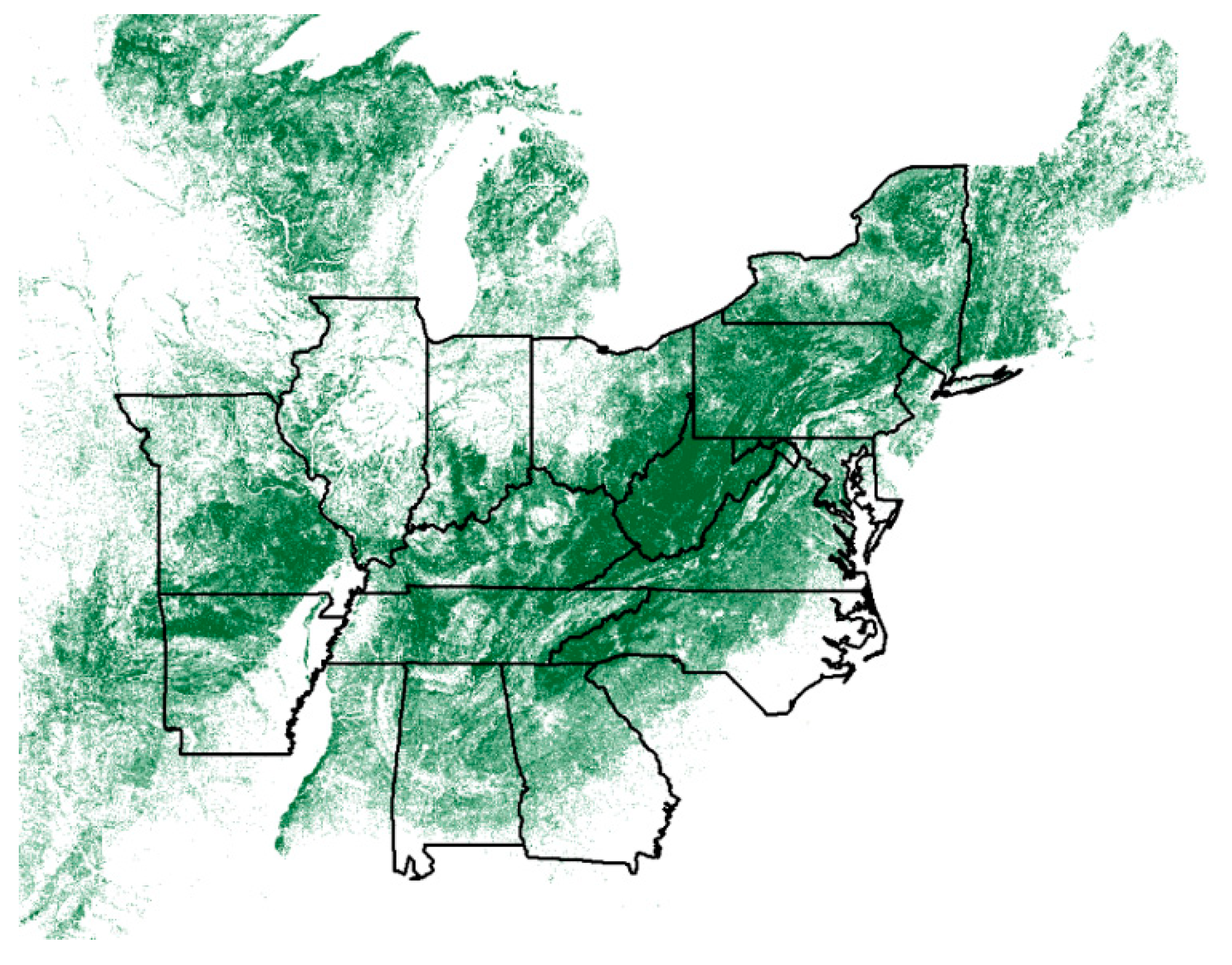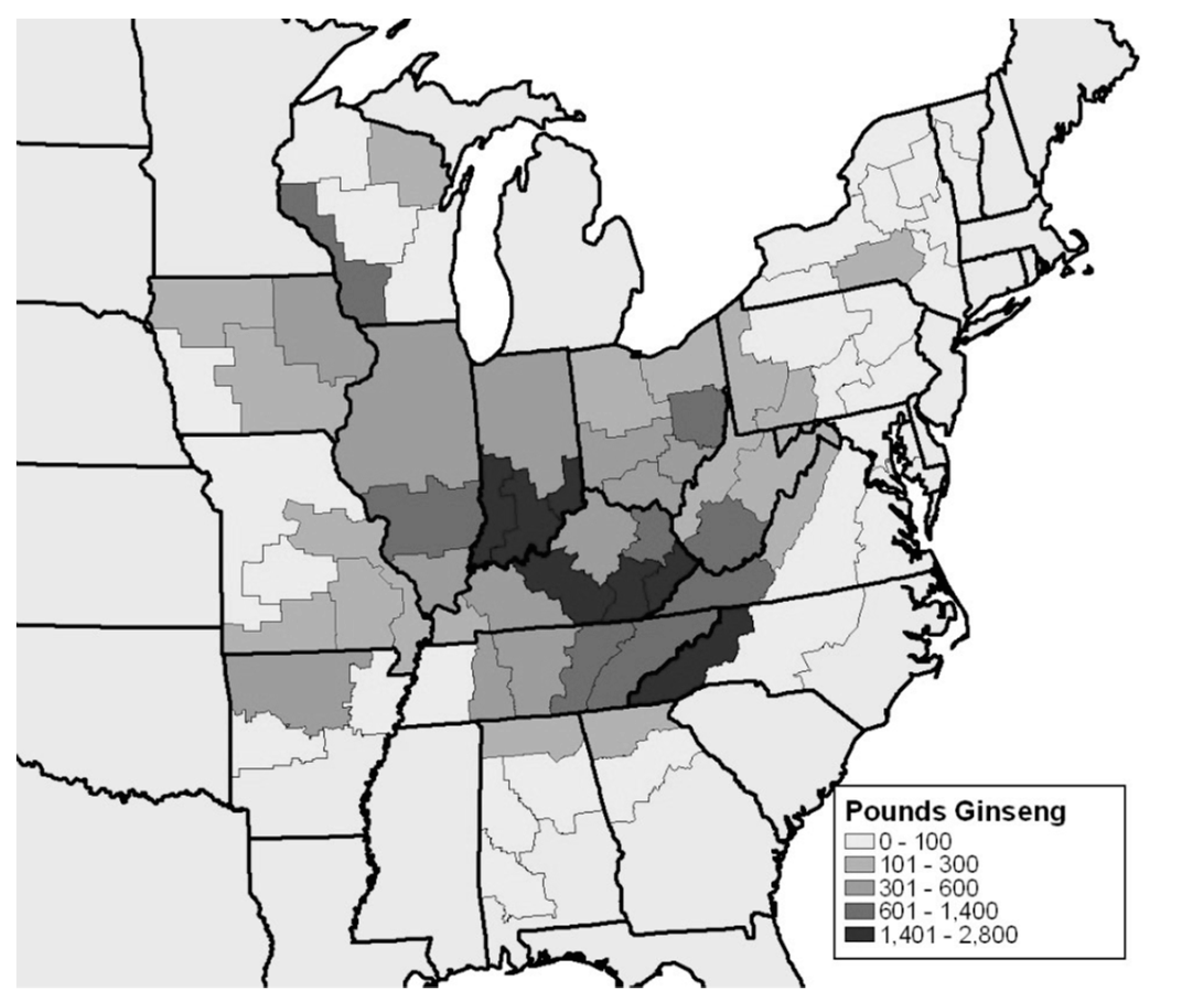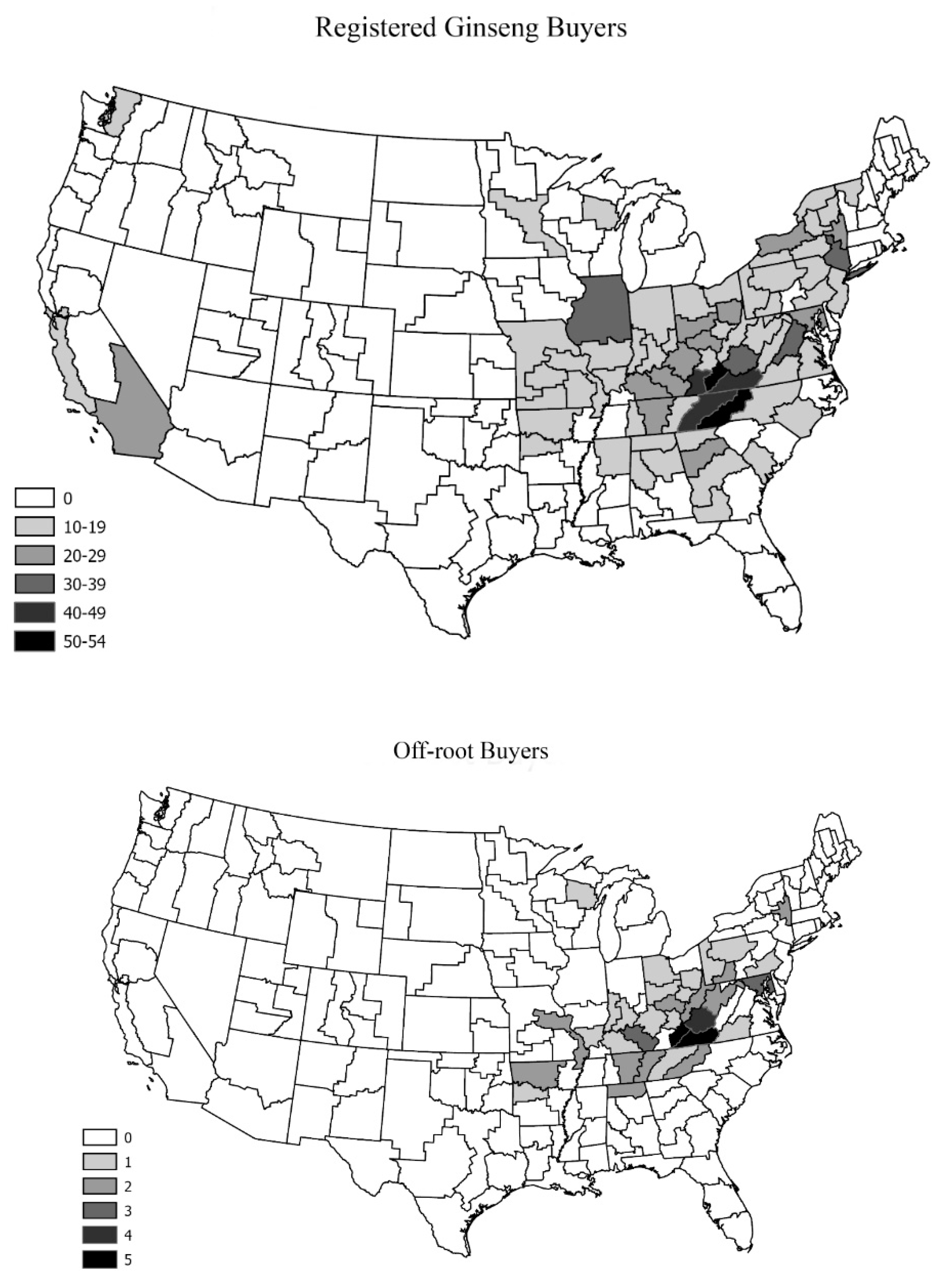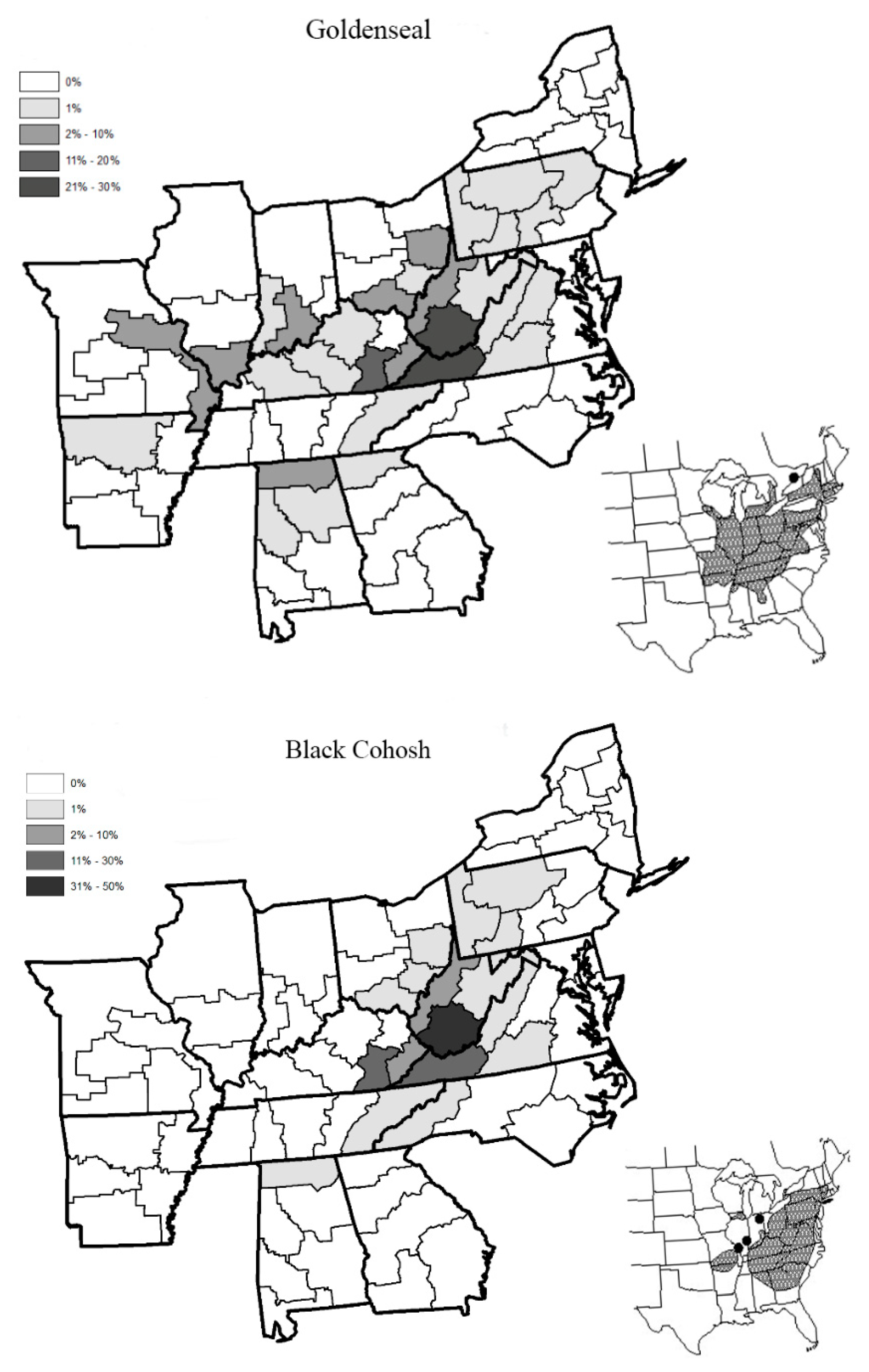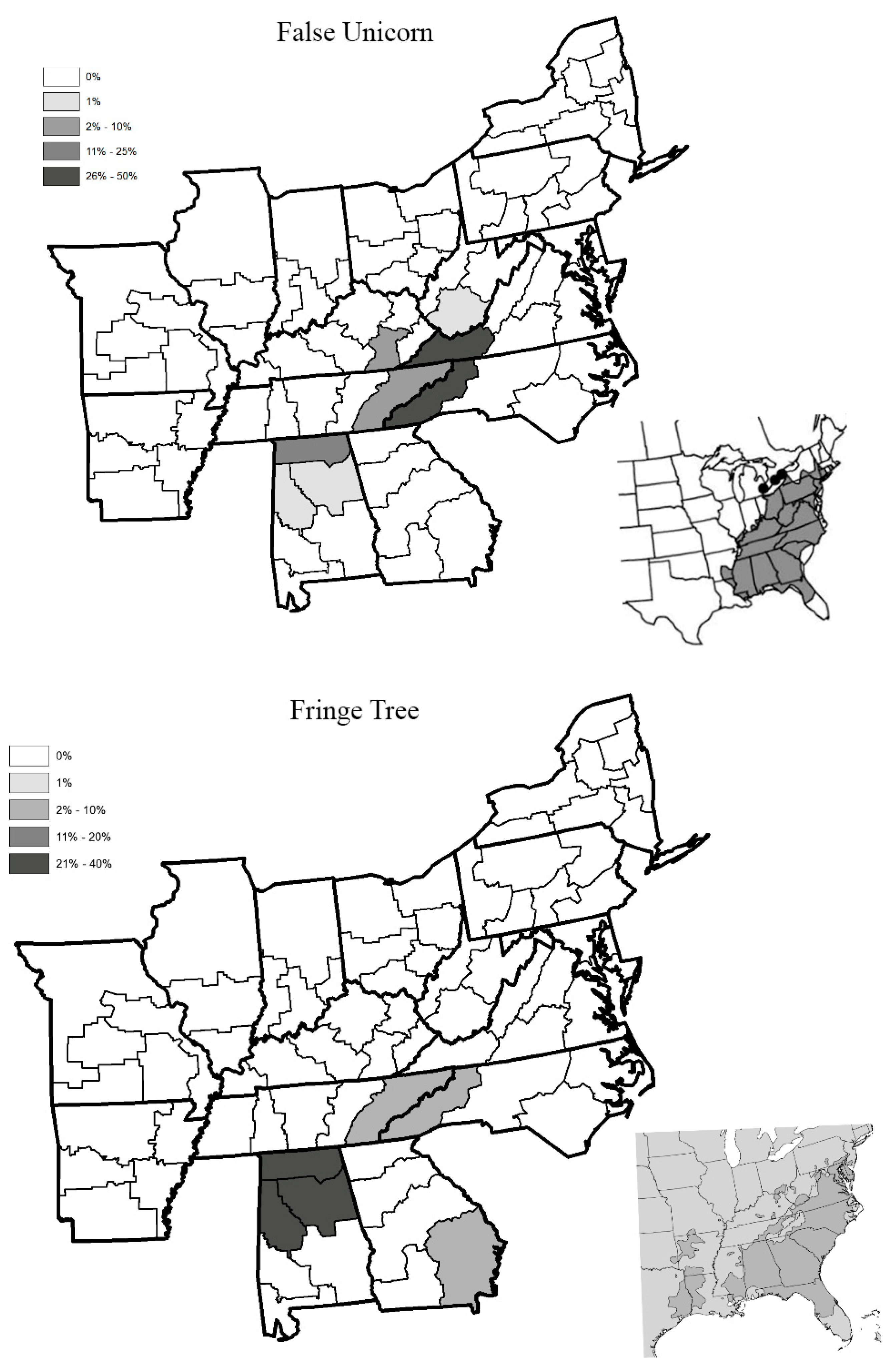1. Introduction
Numerous plants and fungi are harvested from eastern United States (US) forests for medicine, food, crafts, and decorative products [
1,
2]. Medicinal forest products have been exported from eastern US forests for centuries to supply global consumers, and an estimated 50% of North America’s commercial medicinal forest plant and tree species are native to this ecosystem [
3]. Medicinal plant trade has also played a significant role in regional rural livelihoods, recreation, and cultural identity [
4,
5,
6]. However, with the exception of American ginseng (
Panax quinquefolius L.), which is regulated under the 1974 Convention on International Trade in Endangered Species of Wild Fauna and Flora (CITES), little is known about how raw material trade varies across species and throughout the region [
2]. A lack of such data inhibits the effective management of medicinal non-timber forest products (NTFPs) because little is known about what is harvested and from where, as well as the associated market value.
Vaughan et al. [
7] argue that systematic and inclusive annual analysis of the US market for NTFPs such as forest medicinal plants would benefit stakeholders by providing replicable and trackable single-source trade information, such as products that are harvested, and their origin and market structure. Such information can reduce risk and volatility for market actors [
8]. Globally, the lack of data on NTFP markets is also a barrier to entry for producers, landowners, and managers interested in farming medicinal plants using agroforestry methods, managing existing stands for production, or including NTFPs in sustainable development initiatives [
9]. However, tracking programs can be burdensome for harvesters and buyers. Within an informal supply chain, as is often the case with NTFPs, harvesters and buyers may also be difficult to locate and reluctant to participate [
9].
Ginseng is tracked by state and federal agencies in the US because of its CITES status, and buyers must register and obtain a license each year to deal in raw material trade. They also report data on the volume and location of sales. The same cannot be said for other medicinal forest products harvested from the same forests, which are locally referred to as ‘off-roots’ [
10]. Thus, it is difficult to assess the scope, loci of transactions and harvests, and supply chain structure for off-root species that constitute a substantial portion of overall medicinal NTFP trade in eastern US forests.
Harvesters themselves are too numerous and diffuse to effectively sample without significant coverage error [
11]. Manufacturers and retailers may be easier to locate, but are less likely to know from where raw materials are sourced and likely deal with material in different states of processing (i.e., whole roots, powders, tinctures). This complicates estimating output in terms of raw material. The regulatory framework around ginseng provides a pathway for measuring off-root transactions at the primary point of sale. Because ginseng buyers in the US are required by law to register and obtain an annual license, they represent the only publicly available delimited population of active traders in medicinal NTFPs with a business mailing address. Kruger and Chamberlain [
12] studied purchasing behavior among registered ginseng buyers and found that 30% purchased off-roots. The high value and cultural significance of ginseng made it likely that those purchasing other species would also buy ginseng. This is further reflected in the term off-roots, which was used by respondents and is a reference to the secondary importance of those species compared to ginseng, which Kruger et al. [
10] confirmed.
While studies have demonstrated that there are a large number of other species being purchased [
13], it is not known which are the most commonly purchased, and which species make up what proportion of the trade. Greene et al. [
14] and Greenfield and Davis [
3] laid out the general structure of trade in the states of Virginia and North Carolina, respectively, indicating that a large number of small local buyers purchase from harvesters and sell to a smaller number of aggregators. While Appalachia is considered the primary source for these species, the distribution of trade within the region is not well understood. The study hypotheses were:
Registered ginseng buyers purchase off-root species, and can be used as a sample frame for obtaining data about harvests of those species;
The structure of markets will include a number of small buyers supplying a few regional aggregators, with some small buyers also selling directly to consumers;
Since the trade is coincident and off-root species often share the same habitat, trade distributions will be similar to ginseng, with the majority of products coming from southern and central Appalachia.
To test the potential systematic study of off-root output, licensed ginseng buyers were used as a population frame for a survey on buying behavior. Descriptive data provided by licensed ginseng buyers also improves the understanding of the types of traders that participate in ginseng-only versus off-root and ginseng markets, the variety of species being traded, and the regional variability in the volume of medicinal NTFP species they trade.
2. Medicinal Product Trade in the Eastern United States
Deciduous forests cover roughly 1.2 million square kilometers of the eastern US (
Figure 1). They are the predominant type of forest cover, extending from the Piedmont in eastern states such as Virginia, to the Great Plains, and from Gulf states such as Georgia to the Canadian border. Oak–pine forests extend inland from the southern and eastern borders of the region. Oak–hickory forests dominate in the interior, transitioning to maple–beech–birch in the North. The largest areas of contiguous deciduous forests occur along the Appalachian Mountain chain, stretching from northern Georgia and Alabama, then north to New England [
15]. This area includes most of the major eastern deciduous forest groups and the biologically diverse area in central Appalachia known as the mixed mesophytic forest region [
16]. Along with the Ohio River Valley, Appalachia has historically been a center of production for ginseng and off-roots [
5,
17,
18].
Medicinal NTFPs have been harvested from eastern US forests for commercial sale since the 1700s. Among the earliest was ginseng, a slow-growing perennial herbaceous plant highly valued for its roots, which were and are still primarily exported to Asian markets [
13]. Ginseng is the most valuable and iconic of the eastern medicinal NTFPs and remains a key component of the region’s contemporary medicinal trade. Many of the other marketable medicinal NTFP plant species, or off-roots, are companions to ginseng, found in the same mesic forest habitat [
20].
In the 1840s, traders in western North Carolina began to supply a growing domestic and European market for an array of native medicinal plants [
5,
21]. While there was folk use of these species, they also formed the basis of the era’s mainstream conventional medicine [
22]. This trade gradually spread throughout Appalachia and to other parts of the eastern US. By the 1870s, large buyers like the Wallace Brothers of Statesville, North Carolina, were purchasing millions of pounds of hundreds of species annually, including roots, barks, foliage, flowers, and fungi [
5]. They sourced their products from a network of hundreds of small country stores, who bartered raw material with an estimated 40,000 harvesters [
5,
21]. This trade was part of a seasonal livelihood strategy that supplemented agricultural income, and provided a buffer during boom and bust cycles of timber and mining [
23]. Receiving immediate cash from labor without other investment has allowed harvesting to continue to serve as a safety net in economically depressed areas [
24].
Trade in medicinal NTFP species subsided in the first half of the 20th century with the shift to synthetic medicine, but some demand remained, particularly in Europe [
17]. The rise of the popularity in herbal medicine in the last quarter of the 20th century increased demand for off-root species like goldenseal (
Hydrastis canadensis L.), slippery elm (
Ulmus rubra Muhl.), and black cohosh (
Actaea racemosa L.) [
3]. The American herbal products industry as a whole continues to grow today, and stands at an estimated
$7.2 billion dollars in annual retail sales [
25].
While the supply chain is global, NTFP harvests in the forests of the eastern US continue to be a culturally significant local tradition, a form of recreation, and are a source of other value in addition to income [
1,
26]. Harvesters either purchase on speculation or respond to local buyer demand. Local or primary buyers often purchase herbs and roots as part of a diversified business strategy. Examples of associated trade include metal recycling, sporting goods, fur trading, and country stores [
3,
14]. Primary buyers sell to aggregators, who bridge the formal and informal sectors of the NTFP herbal products industry and generally sell to exporters, wholesalers, and manufacturers. As a result, most raw material leaves the region as a commodity bound for various manufacturing markets such as chopped and powdered roots and herbs, tinctures, and supplements [
14].
Eastern deciduous forests are not commonly managed for medicinal NTFPs, and the trade volume, market structure, and harvest distribution of most species are not systematically measured [
2,
7]. Data are collected on public lands that permit harvesting (e.g., [
27]) and non-replicated surveys have been conducted with market actors [
3,
11] resulting in a basic understanding of market structure and some estimates on price and total output. But these data vary dramatically, demonstrating the need for a replicable and systematic approach that integrates different data that can be correlated with forest monitoring, such as is currently done in the US pertaining to timber products.
The American Herbal Products Association (AHPA), an industry advocacy organization, collects output data for a number of species commonly harvested from the wild [
28], but historically they have not documented harvest location or market structure. There are no geospatial harvest distributions recorded for any species other than ginseng, meaning little is known about how wild populations of off-roots are impacted throughout their natural range, and what factors drive harvesting at the local level. Ginseng harvest distributions were studied and mapped in Chamberlain et al. [
29] (
Figure 2). For ginseng, southern and central Appalachia, as well as the Ohio River Valley, were centers of production. Eastern and central Kentucky, western North Carolina, and southern Indiana were the regions with the highest output. Due to the overlapping habitat of many off
-root species with ginseng, and the higher value and popularity of ginseng harvesting, it is less likely that buyers would purchase off-roots and not purchase ginseng. A map showing distribution of off-root purchases would then resemble the distribution of ginseng purchasing.
4. Results
One hundred and eighty licensed ginseng buyers responded over the course of two years of surveys, with a 26 percent response rate. Their responses were summed and used to generate descriptive statistics about market activity. Twenty-nine percent (n = 52) purchased no medicinal NTFPs. Thirty-eight percent (n = 69) bought only ginseng. Thirty-three percent (n = 59) reported purchasing off-root NTFPs. No buyer respondents reported buying off-root NTFPs and not ginseng, and 46 percent of those who bought ginseng also bought off-root species. Within these broad groups are several types of buyers with their own patterns of purchasing: side or specialty (small); seasonal venture (medium); large integrated or dedicated business (large); and dedicated bulk enterprise (regional aggregator).
4.1. Products and Proportions
Data on purchase frequency for off-roots were obtained from 283 total responses obtained over the period from 2015-2016 for buying years 2014 and 2015 (
Table 2). Each response was treated as unique, as opposed to the buyer typology data where data from individual buyers over multiple years were consolidated. This was to capture the full scope of species purchased and their total frequency for that time period, which could fluctuate from year to year. Off-root species were purchased at three different levels of frequency. The most commonly purchased was goldenseal (32%), followed by bloodroot (25%), and black cohosh (22%). This order was the same in all three years. If a buyer respondent only purchased a single off-root NTFP, it was likely to be one of those three. In the next tier, species like mayapple and Virginia snakeroot were purchased by 5–15 percent of the respondents. The remaining products were only purchased by a few buyers and aggregators. Most of these were bought in small amounts, with the exception of slippery elm bark, which was purchased by only a few buyers, but still accounted for a substantial portion of trade volume. Goldenseal, black cohosh, and slippery elm together accounted for over 90 percent of total reported off-root volume.
Twelve percent of the buyer respondents reported purchasing off-root species other than those listed in the survey (
Table 2). In total, 62 NTFPs were traded by respondents, including 47 additional roots, barks, and aerial parts such as leaves and flowers, and medicinal fungi such as reishi (
Ganoderma spp. P. Karst) and chaga (
Inonotus obliquus Ach. Ex Pers). In some cases, buyer respondents reported purchasing more than one plant part for the same species, such as goldenseal, which has a market for both its rhizome/root and aerial parts. Some respondents provided their business web address, enclosed buying lists, or wrote “hundreds of others”, indicating that there were many more off-root species harvested in the region. Three percent of the buyer respondents purchased non-medicinal NTFP plants and fungi. The most commonly purchased were decorative products such as log moss, edibles such as ramps (
Allium triccocum Ait.), mushrooms (such as
Morchella spp. Dill), and sassafras (
Sassafras albidum Nutt.) leaves for file powder used in Cajun and Creole cooking, and craft products such as wood burls.
4.2. Trade Distribution
Areas of central Appalachia as defined by the Appalachian Regional Commission (southern West Virginia, eastern Kentucky, and far southwestern Virginia) were main supply centers for off-root products. This concentration was true in terms of harvested material, and the tendency to purchase off-root species (
Figure 3). The Appalachian FIA units in Kentucky, Ohio, Virginia, and West Virginia supplied 82 percent of the bloodroot, 99 percent of the black cohosh, and 83 percent of the goldenseal purchased during the study period. Additional trade occurred in southern Indiana, and the Appalachian regions of Alabama, North Carolina, and Tennessee. Limited production was observed in Appalachian Maryland and Pennsylvania, and in the Ozark Plateau of Arkansas and Missouri.
The off-root NTFP purchased most commonly throughout the study area was goldenseal (
Figure 4), but it had a more concentrated area of trade compared to that reported for ginseng in Chamberlain et al. (2013) (
Figure 2). Trade in other commonly sold species (e.g., black cohosh) were even more concentrated (
Figure 4), with some areas where ginseng is regularly harvested reporting comparatively little trade, such as western North Carolina. There were exceptions to this harvest distribution. False unicorn (
Chamaelirium lutem) and fringe tree bark trade were concentrated in the south, with more trade occurring in Alabama and North Carolina (
Figure 5).
4.3. Buyers and Business
Sixty-one percent of respondent buyers purchased less than one hundred pounds (<45 kilograms (kg)) of off-root raw material (
Table 3). These NTFP tradespeople can be considered side or specialty (small). Buyers of small amounts of off-root products tended to be located in the FIA unit where they purchased raw material and were more likely to sell directly to consumers and to create value-added products, although the majority sold to aggregators. Small buyers were responsible for an average of four percent of the total off-root volume purchased from harvesters for the three most commonly traded off-root species (black cohosh, bloodroot, and goldenseal). They bought directly from harvesters and, on average, purchased only the three most commonly traded off-root NTFPs. This was the fewest number of species purchased among all buyer types.
These small off-root buyers were not monolithic. Some contacted during the survey claimed to buy a few other products as a way to attract ginseng harvesters, and sold to aggregators. However, small buyers were also were more likely to harvest their own raw material, manufacture their own products, or sell directly to retailers and consumers when compared to other buyer types, indicating a second sub-category of small specialty buyers. Practicing herbalists (those who provide herbal medicine directly to clients) also were in the small buyer category.
Like side and specialty buyers, seasonal venture (medium) buyers typically traded in or near to the FIA research unit where their business was located. Often, they were buying for a longer period than the ginseng season, but most of their enterprise was part of a diversified business, or a supplement to unrelated full-time work. Medium buyers bought hundreds of pounds (45 to 450 kg) of off-root raw material and made up 27 percent of the buyers who purchased off-root species. They accounted for a ten percent share of the observed trade for the three most popular off-root species. On average, medium buyers traded in five of the surveyed species and were most likely to sell their products to aggregators.
The majority of the plant material purchased directly from harvesters was concentrated within a small number of dedicated businesses (large). These large buyers accounted for only seven percent of the off-root buying respondents, but purchased 86 percent of the three most common off-root species. They purchased thousands of pounds (>450 kg) of material directly from harvesters, and some ran businesses entirely devoted to medicinal products. Dedicated businesses primarily sold their raw material to aggregators within and outside the region and, on average, they traded in 12 of the 15 off-root medicinal NTFPs in this study.
Regional aggregators accounted for only five percent of the respondents. This type of buyer may or may not have been located in the study region, but they were involved in the majority of the total trade volume for all but one of the surveyed off-root NTFPs. On average, they purchased over half (51%) of the volume in the three most commonly purchased off-root species (when including material from harvesters and other buyers). Regional aggregators bought raw material from harvesters locally, but tended to purchase the majority of their material from a network of primary buyers throughout the region. As such, they were active in an average of eight FIA research units compared to less than two for all other buyer types. These businesses tended to focus exclusively on herbal products, and sold to manufacturers, larger aggregators, and exporters. They also had more employees compared to their smaller counterparts, with an average of three part-time and two full-time employees as opposed to an average of one employee across all other buyer types.
5. Discussion
Based on previous research on the region’s medicinal product trade [
3,
12,
14], ginseng buyers were expected to also purchase other species. This was found to be the case. While only a third of the responding ginseng buyers in this study purchased off-roots, a third reported purchasing no products at all, including ginseng. Almost half of those who did purchase ginseng bought other NTFPs. Ginseng buyers may not purchase off-roots for a variety of reasons. While they are harvested and sold in the same places, the end market for ginseng is primarily Asia, while most off-roots are used in Western herbalist traditions [
3]. Some buyers are located in large cities, and are ginseng exporters, or herbal practitioners within Asian–American communities who do not purchase off-root species native to the region. Ginseng also has a defined season, and the high prices mean the root can be traded profitably in smaller amounts compared to some of the lower-value off-root NTFPs, requiring less infrastructure, and less investment in capital and time. A lack of a harvesting tradition or familiarity with off-root species may also play a role.
There are different tiers of off-root buying, showing that the concept of many small buyers supplying aggregators represents an incomplete picture of the supply chain. For some, buying small or medium amounts of off-root NTFPs is a supplement to seasonal ginseng trade, or one facet of a diversified business [
14]. Small buyers who make value-added products or market directly to consumers may have a larger profit margin, so small amounts may be more economically significant, and purchasing may take place throughout the year. For larger dedicated herbal product businesses, medicinal plants may be the sole source, or the majority of income. These large buyers, while small in number, are responsible for the majority of the off-root raw material being sold.
Buyers reported buying a wide array of products, and over 60 species. However, the majority of purchasing in terms of frequency, trade volume, and value is accounted for by a small number of off-root species, primarily goldenseal, black cohosh, and bloodroot in terms of frequency and slippery elm in terms of trade volume. The most commonly harvested off-roots were goldenseal, followed by bloodroot and black cohosh. These were bought by between 20–30 percent of respondents. NTFPs such as false unicorn and mayapple were bought by around 10 percent of the buyer respondents, and trade in many other off-root species were at rates below five percent, though these species were often entered voluntarily through the write-in option. This indicates that the study only captured part of the picture in terms of the total medicinal species purchased, but that the survey collected data on the off-root NTFPs that are most commonly traded. Similarly, while a small number of buyers bought edible and decorative NTFPs, it is likely that trade was moving through a different supply chain. Just three products, black cohosh, slippery elm, and goldenseal, accounted for over 90 percent of the total reported off-root volume.
Harvest distributions have not been previously generated for the off-root NTFPs in this study. The original anticipation was that the distribution of off-root trade would be similar to ginseng, given the shared supply chain and habitat. Off-root transactions occurred in all 15 states, but the coalfield FIA research units in central Appalachia were a trading hotbed. Even aggregators based outside this core production zone sourced the majority of off-root NTFPs from central Appalachia. This area is also a major source of ginseng, but ginseng is harvested across a larger number of FIA units. Some areas that once involved large amounts of off-root trade, such as east Tennessee and western North Carolina, account for large ginseng harvests but do not appear to be—presently—major sources of off-root material, demonstrating that these NTFP species have a more concentrated harvest area.
Schmidt et al. [
18] found that the combination of proximity to potential habitat and socio-economic conditions such as poverty and unemployment are correlated with high ginseng production. This is likely also the case for off-roots in central Appalachia as well, since the area contains abundant plant habitats [
29], and is economically marginalized [
36]. Socio-economic factors may play an even greater role for species that are more common, of lower value, and have less cultural significance than ginseng. The region has been profoundly shaped by the coal and timber industry [
37], and it contains the greatest concentration and the largest contiguous tracts of forest within many of the natural ranges for off-root species [
15,
34]. These large areas of corporate and often absentee-owned forestland have traditionally been utilized as a de-facto commons for harvesting NTFPs [
4,
6]. The coalfields also contain the highest concentrations of economically distressed counties, and the highest unemployment and poverty within the natural ranges of many off-root species [
36], largely because of the decline of coal and other natural resource industries in the region, and a lack of economic diversification or transition to other economies [
38]. Plant ranges, or the tendency for plants to be more common within certain parts of their ranges, may also influence trade distribution. This appears to be the case for species such as fringe tree and false unicorn.
These findings have implications for managing forests for NTFPs, and assessing and promoting sustainability. The economic and cultural significance of NTFPs has led to their inclusion in initiatives seeking to blend forest conservation with economic development [
9,
39,
40,
41]. If the information is made available, traditional participants, institutions, and market actors working for sustainable production either through certified wild stewardship or through an increase in cultivation in forests (forest farming) can benefit from market analysis, which can help understand demand, insulate participants from risk, and steer efforts toward higher value species of greater need [
42]. Information about trade distribution can help focus management and institutional support for sustainable production and conservation in the places where trade is concentrated and has the greatest economic and cultural significance.
Understanding the nuanced differences between categories of market actors helps illuminate the effects of NTFP policy throughout the supply chain, and target NTFP support programs more effectively. Larger buyers and aggregators may have a greater impact due to their far-reaching network of harvesters and buyers, and the volumes they purchase. Undiversified herbal products businesses have more at stake in the industry and its future compared to smaller buyers for whom buying ginseng or off-root NTFPs may be a side business. Conventional small and medium buyers typically have slimmer profit margins and less investment in the NTFP-dependent herbal and edible products industry, meaning they may not be able to spend money and time on certification or bear the costs of complying with formal policies. Specialty buyers, while small, may also be more flexible and likely to participate in product certification and scaled manufacturing because many harvest their own material, market to consumers, and create value-added products. Harvesters, though numerous and decentralized, have perhaps the most to lose or gain, and should be, but are rarely, engaged by policy makers, industry advocates, and supporting institutions.
While the kinds of descriptive market data collected in this study can help inform these efforts, they do not allow for an assessment of the sustainability of harvests in terms of population viability. That requires comprehensive information pertaining to the condition of existing populations and biological responses to harvests, as well as other threats such as habitat loss. Off-root species stocking, with the exception of trees included in the FIA program (e.g., slippery elm), is not known across the region, although some studies have been done at the state level (e.g., [
43]). Others have looked at responses to experimental harvests (e.g., [
44,
45]), but only for a few species. Systematic monitoring of populations correlated with replicated estimates of output and the kind of data presented here are needed to effectively manage and conserve off-root NTFP species. Some of this work can be folded into existing forest management and measurement initiatives, such the USFS FIA program. A better understanding of existing harvesting practices, the demographics of harvesters, and the economic and cultural value of these species is also vital for assessing the current state of the industry, and the potential effects of changing policy or institutional investment in the NTFP bioeconomy.
